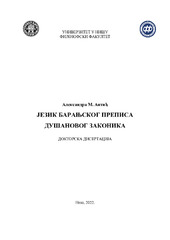Приказ основних података о дисертацији
Jezik Baranjskog prepisa Dušanovog zakonika
| dc.contributor.advisor | Jović, Nadežda | |
| dc.contributor.other | Kurešević, Marina | |
| dc.contributor.other | Stošić, Jelena | |
| dc.creator | Antić, Aleksandra M. | |
| dc.date.accessioned | 2023-03-28T21:13:45Z | |
| dc.date.available | 2023-03-28T21:13:45Z | |
| dc.date.issued | 2022 | |
| dc.identifier.uri | http://eteze.ni.ac.rs/application/showtheses?thesesId=8585 | |
| dc.identifier.uri | https://fedorani.ni.ac.rs/fedora/get/o:1860/bdef:Content/download | |
| dc.identifier.uri | https://plus.cobiss.net/cobiss/sr/sr/bib/84357641 | |
| dc.identifier.uri | https://nardus.mpn.gov.rs/handle/123456789/21338 | |
| dc.description.abstract | Despite the fact that Dušan’s Code is one of the most significant monuments in the history of Serbian law, the language of none of the twenty-five transcripts published so far has been analyzed in detail. The subject of this dissertation is the research and description of graphic, spelling, and linguistic characteristics of the Baranja transcription as one of the older transcriptions of the Dušan’s Code. The application of the descriptive method enabled a comprehensive description of graphic and spelling characteristics of the manuscript, which was important not only for describing and studying the phonetic and phonological side of the manuscript, but also for describing and studying characteristics at higher levels of linguistic structure (morphological, word formation, syntactic and, lexical). A detailed analysis of the graphic and spelling system of the Baranja transcription indicated some hesitation in the choice of certain solutions, which could be expected, given that this is a manuscript from the post-Resava period. The intertwining of the Raška and Resava manners of writing was undoubtedly influenced by the fact that this is a document copied from a template that probably dates from the 14th century. To create a more complete picture of the language of Serbian medieval monuments from the 15th and 16th centuries, the linguistic characteristics of the Baranja transcription were compared with the characteristics of the already described documents of the approximate time of origin, ie. close genre affiliation. Monitoring the share of Serbian vernacular and Serbian Church Slavonic language characteristics at different language levels, conducted in an attempt to determine the type of language in legal documents, showed that the Baranja transcription of Dušan’s Code was written mostly in the vernacular, while editorial characteristics were sporadic. As the attested vernacular characteristics were mostly of a general Štokavian character, the dialect base of the scribes could not be determined. It should also be noted that, during the linguistic analysis, we did not find any characteristics that would call into question or refute the dating of the Baranja transcription (first quarter of the 16th century), based on the examination of the watermarks in the document was questioned or refuted. | en |
| dc.format | application/pdf | |
| dc.language | sr | |
| dc.publisher | Универзитет у Нишу, Филозофски факултет | sr |
| dc.rights | openAccess | en |
| dc.rights.uri | https://creativecommons.org/licenses/by-nc-nd/4.0/ | |
| dc.source | Универзитет у Нишу | sr |
| dc.subject | Baranjski prepis | sr |
| dc.subject | The Baranja transcription | en |
| dc.subject | Dušan’s Code | en |
| dc.subject | 16th century | en |
| dc.subject | language analysis | en |
| dc.subject | Dušanov zakonik | sr |
| dc.subject | XVI vek | sr |
| dc.subject | jezička analiza | sr |
| dc.title | Jezik Baranjskog prepisa Dušanovog zakonika | sr |
| dc.type | doctoralThesis | |
| dc.rights.license | BY-NC-ND | |
| dc.identifier.fulltext | http://nardus.mpn.gov.rs/bitstream/id/150387/Antic_Aleksandra_M.pdf | |
| dc.identifier.fulltext | http://nardus.mpn.gov.rs/bitstream/id/150386/Doctoral_thesis_13423.pdf | |
| dc.identifier.rcub | https://hdl.handle.net/21.15107/rcub_nardus_21338 |



